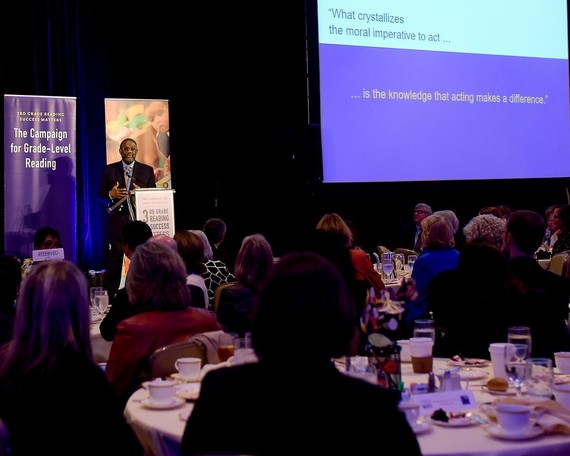There's a long way to go between pre-school success and graduating from high school. We've heard about wonderful programs focusing on early literacy as well as those working to increase the high school graduation rate. But what about the 12 years in between? Who is working to close the gap in the achievement gap?
That is where The Campaign for Grade-Level Reading is taking the lead.
The Campaign is a collaborative effort by foundations, nonprofit partners, business leaders, government agencies, states and communities across the nation to ensure that more children in low-income families succeed in school and graduate prepared for college, a career and active citizenship. The Campaign focuses on an important predictor of school success and high school graduation -- grade-level reading by the end of third grade.
A recent KIDS COUNT data snapshot from the Annie E. Casey Foundation found that 80 percent of lower-income fourth graders and 66 percent of all kids are not reading proficiently.
The National Research Council has stated, "Academic success, as defined by high school graduation, can be predicted with reasonable accuracy by knowing someone's reading skill at the end of third grade. A person who is not at least a modestly skilled reader by that time is quite unlikely to graduate from high school."
The Campaign is at the midway point of its 10-year effort to have at least 12 states and 24 communities increase by 100 percent or more, the number of low-income children reading on grade level by the end of third grade. So how is it doing?
Campaign investors recently gathered in Washington, D.C., to discuss goals and progress.
The good news is a dozen states or more have increased by at least 100 percent the number of low-income children reading proficiently by the end of third grade. However, double-digit gaps persist and co-exist with good progress in every state
Like any good campaign, this one is not sitting still. It is advancing by advocating for "data-driven, technology-enhanced early warning and response systems that will allow timely identification of and intervention with children who are veering off the pathways leading to readiness, attendance and summer learning."
That piece of the puzzle is key. Just because tools and resources are provided, doesn't mean they are being optimized or working for every child. The focus by the campaign on identifying and intervening to help get and keep kids on track is critical to sustainable success.
The campaign is for "unbundling readiness, attendance and summer learning to allow more granular attention to the drivers of improved outcomes in each of these domains."
It is for "extending the collective impact framework to accommodate and support solutions design and development processes that capture the stored value of the GLR Network's distributed strengths, experience and expertise."
Basically, it is for being better together because the schools and the parents can't do it alone. By collaborating to break down barriers, those committed to the campaign are working to ensure every child has the chance to come full circle and graduate prepared for college, career success and active citizenship.


